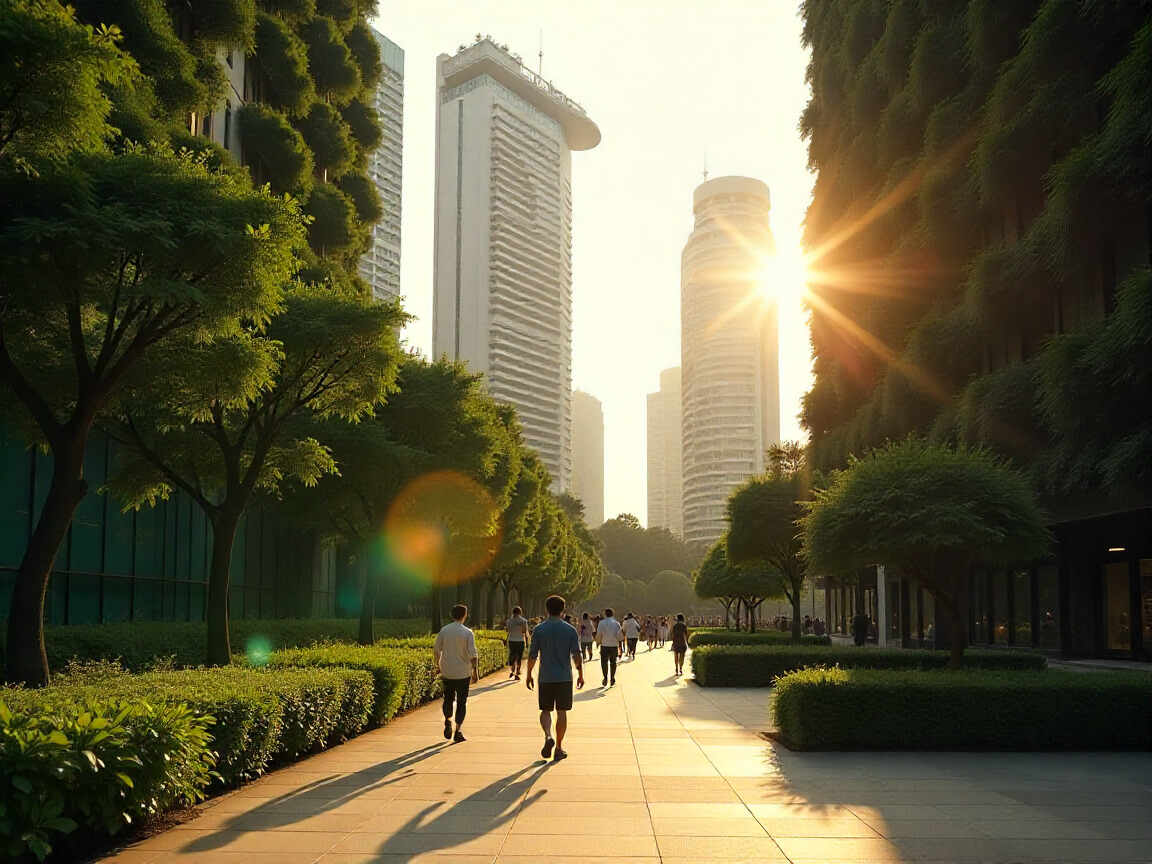سنگاپور نے ملائشیا ، ویتنام ، تھائی لینڈ ، انڈونیشیا اور فلپائن کے ساتھ اتحاد کیا تاکہ عالمی شہری صحت کے مستقبل کو صحت کے لئے اعلی جنوب مشرقی ایشیائی ممالک کی حیثیت سے پیش کیا جاسکے۔
سنگاپور نے ملائشیا ، ویتنام ، تھائی لینڈ ، انڈونیشیا اور فلپائن کے ساتھ اتحاد کیا تاکہ عالمی شہری صحت کے مستقبل کو صحت کے لئے اعلی جنوب مشرقی ایشیائی ممالک کی حیثیت سے پیش کیا جاسکے۔
سنگاپور نے ملائشیا ، ویتنام ، تھائی لینڈ ، انڈونیشیا اور فلپائن کے ساتھ اتحاد کیا تاکہ عالمی شہری صحت کے مستقبل کو سرفہرست جنوب مشرقی ایشیائی ممالک کی حیثیت سے فلاح و بہبود کے لئے شائع کیا جاسکے۔ November 14, 2025The global race for urban excellence is changing. It is no longer enough for a capital city to simply be rich. True success, analysts now confirm, rests on one critical metric: Wellness. Wellness means health, safety, clean air and equitable access for every citizen. A new analysis, based strictly on official governmental data and policy frameworks, identifies the six powerhouses shaping this future. These capitals are setting the new gold standard for metropolitan living. This study reveals how Singapore, Malaysia, Vietnam, Thailand, Indonesia and Philippines are leading a regional revolution in quality of life.The Absolute Benchmark: Singapore’s Gold-Standard GovernanceOne nation stands alone in the measured pursuit of urban health: Singapore. It has established an indisputable quantitative supremacy across the most vital metrics. This success is not accidental. It stems from a continuous commitment to adaptive and rigorous governance.AdvertisementThe ultimate measure of health is longevity lived in full health. Official figures from the Ministry of Health and the World Health Organization (WHO) confirm Singapore’s exceptional performance. Its Healthy Life Expectancy (HLE) at birth reached an impressive 73.6 years in 2021. HLE measures the expected number of years a person can live without suffering from major illness or disability. This figure is a direct testament to highly effective healthcare, world-class sanitation and sophisticated public health planning. This is more than a statistic; it is proof of a policy environment that has consistently improved wellness over decades. Official data shows a robust improvement of 4.24 years in HLE between 2000 and 2021. This incremental progress confirms the city-state’s unmatched policy resilience.  Environmental quality provides the second pillar of this dominance. A city’s clean air is a non-negotiable factor for public health. Singapore sets the regional benchmark for environmental discipline. According to official data from the National Environment Agency (NEA), the city achieved a stunning 100.0% of days falling into the ‘Good’ and ‘Moderate’ air quality categories in 2024. This means the city recorded zero days in the ‘Unhealthy,’ ‘Very Unhealthy,’ or ‘Hazardous’ categories. This stable environment ensures consistent protection against respiratory health risks. It maximizes the utility of public spaces. It acts as a powerful multiplier for Singapore’s high HLE score. This perfect compliance is a quantitative differentiator from almost every peer in the region.  The Invisible Crisis: Urban Safety Shifts from Physical to DigitalSafety forms the foundational layer of any thriving urban environment. Yet, in the most developed capitals, the threat landscape is fundamentally changing. Singapore’s physical security is globally competitive. It recorded a low physical crime rate of 331 per 100,000 population in 2024. This physical stability is a cornerstone of its quality of life.  However, a new and invisible crisis threatens urban wellness. The focus of crime has transitioned from physical harm to economic and digital security. Official data reveals a staggering surge in digital threats. Scams and Cybercrimes cases recorded a massive 55,810 incidents in 2024. This number far exceeds physical crimes.  AdvertisementThis trend sends a clear message. Public safety in highly developed capitals is now defined by digital wellness. If government systems effectively mitigate physical harm, but citizens face rising financial vulnerability, the overall quality of life is compromised. Singapore’s commitment to urban wellness now requires formal strategies to combat sophisticated economic fraud and cybercrime, ensuring financial well-being alongside physical security.The Contenders: High-Performance Health Hubs and Policy AlignmentBeyond the absolute benchmark of Singapore, other major capitals demonstrate powerful, localized strengths that secure their place among the elite.Malaysia: Kuala Lumpur’s Concentrated Health ExcellenceKuala Lumpur (KL), the dynamic capital of Malaysia, proves the success of centralized resource allocation. While national life expectancy is high (expected to reach 75.6 years in 2021) , the Federal Territory shows distinct advantages. Department of Statistics Malaysia data confirms that W.P. Kuala Lumpur recorded the highest life expectancy at birth for females in the entire country in 2019, reaching 79.2 years. This local excellence proves that KL efficiently concentrates health resources and quality infrastructure. The spatial concentration of superior longevity confirms the capital acts as a crucial hub for quality of life enhancement within the national economy.  However, KL faces persistent challenges common to rapidly growing metropolises. Environmental volatility is a major drag on its wellness score. Air Quality Index (AQI) levels frequently fluctuate, often pushing into ranges considered ‘Unhealthy for Sensitive Groups’ (above 100) or ‘Unhealthy’ for the general population (above 151). When residents must restrict outdoor activity due to pollution, the value of green spaces and recreation is functionally undermined. Furthermore, Kuala Lumpur is a major center for high-value economic fraud. It recorded losses exceeding RM54.5 million from 913 telecommunication fraud cases. This shows that superior financial services must be paired with superior digital security to protect citizens’ financial wellness.  Thailand: Bangkok’s Institutional ResilienceBangkok, the bustling capital of Thailand, is a strong policy contender defined by institutional engagement and transparency. Despite facing significant urban pressures, Thailand’s commitment to urban health policy is clear. Its Ministry of Public Health (MOPH) is an active participant in the WHO South-East Asia Region (SEAR) Healthy Cities network. This alignment reinforces the government’s dedication to systematic urban health improvement.  Bangkok exhibits volatility, particularly in environmental management. Its PM2.5 AQI has recently spiked as high as 133. These pollution peaks require officials to advise limiting prolonged outdoor exertion. This constant struggle acts as a persistent constraint on comprehensive urban wellness. On the safety front, traditional crime remains a challenge. Official police reports show the homicide rate increased to 2.6 per 100,000 population in 2024. But Thailand’s government is tackling complex issues head-on, focusing heavily on drug suppression, with over 200,000 drug offenses resolved in 2024. This strong institutional capacity to manage massive public health and safety challenges provides the necessary foundation for sustained wellness initiatives.  The Equity Factor: Affordability as the True Measure of WellnessAbsolute metrics alone fail the test of equitable urban wellness. A city cannot be truly well if its benefits are restricted only to the affluent. The affordability of life is a vital measure of social inclusion.Vietnam: Hanoi’s Focus on Cost-EfficiencyHanoi, the capital of Vietnam, ranks highly on the principle of equity-efficient wellness. The government’s explicit commitment to managing affordability is a powerful indicator of social wellness. The General Statistics Office actively reports on the Consumer Price Index (CPI). CPI monitoring is one of the most important indicators tracked by governments to safeguard citizens’ well-being. Vietnam’s CPI tracking, which reported an increase of 3.25% in October 2025 compared to the same period the previous year , signals official dedication to controlling the cost of living.  Affordability maximizes access to essential services for a wider demographic. Hanoi’s comparatively lower cost structure, especially against high-cost cities like Singapore, allows it to potentially achieve superior equitable wellness. This strategic focus aligns perfectly with the overarching ASEAN mandate for inclusive growth and poverty eradication.  The Strategic Centers: Policy-Aligned Potential in Indonesia and PhilippinesThe inclusion of Jakarta and Manila is based not only on current performance but also on their central governmental roles and demonstrated capacity to implement advanced policies, positioning them for rapid ascent in future wellness rankings.Indonesia: Jakarta’s Urban Resilience PivotJakarta, the monumental capital ofIndonesia, is included due to its central role in regional policy implementation. Indonesia is critical to ASEAN’s focus on strategic resilience and inclusive development. As a burgeoning megacity, Jakarta requires immense governance capacity to manage complex urban pressures. Its size necessitates aggressive, sophisticated policy measures to maintain livability.  The city’s importance aligns with regional initiatives, such as the ASEAN Catalytic Green Finance Facility (ACGF). This program aims to mobilize funding for sustainable development projects. Jakarta’s capacity to leverage these strategic mechanisms is a crucial proxy for its commitment to long-term environmental and infrastructural wellness. Its success will be a bellwether for how the entire region manages the consequences of rapid urbanization.  Philippines: Manila’s Environmental Governance CapacityManila, the capital of the Philippines, possesses the crucial policy capacity for specialized environmental governance. The technological and governmental structures needed for Environmental Sustainability exist within the national framework. The precedent is clear: Bohol Province in the Philippines was the first local government in Southeast Asia to acquire an Environmental Management Systems certification.  This precedent confirms the policy intention and operational capacity within the Philippines to deploy aggressive environmental management systems. This serves as a strong proxy for Manila’s potential. Scaling this localized success is the primary challenge. When successful, the capital will see a significant boost in its environmental and quality of life scores. Its potential to improve resource conservation and integrated development planning justifies its high strategic ranking.  The Global Mandate: Strategic Implications for the FutureThe comparative analysis of Singapore, Malaysia, Vietnam, Thailand, Indonesia and the Philippines shows a clear regional trend. The pursuit of urban wellness is fundamentally shifting.The defining challenge is balancing the necessity of high-quality services (requiring massive investment) with the imperative of equitable access (requiring managed costs and subsidies). The future success of these capitals hinges on their ability to translate policy intentions into measurable, equitable outcomes for all citizens.  For capitals like Kuala Lumpur and Bangkok, volatile air quality represents the most immediate threat to physical wellness. The inability to consistently maintain low pollution levels critically undermines investments in recreation and public health. Aggressive congestion pricing and strong public transport investments are vital steps needed to control local emissions.  Furthermore, all capitals must formally integrate Digital Wellness into their core strategies. The significant rise in scams and cybercrimes is a major public safety risk. It impacts citizens’ financial stability and overall well-being. Governments must act through proactive consumer protection and cross-border law enforcement collaboration to combat sophisticated fraud.  The ultimate goal is synthesis. The successful capitals of the future will effectively blend Singapore’s gold-standard public health performance and environmental stability with the cost-efficient, inclusive growth objectives prioritized by Vietnam and the broader ASEAN framework. Failure to manage costs and control infrastructure constraints will compromise the equity dimension, regardless of absolute success in health or environment. These six capitals are now locked in a dynamic competition. Their commitment to transparency and measurable governance will ultimately dictate the quality of life for millions, forging the path for global urban health.AdvertisementTags: Asia, Best Countries for Wellness, malaysia, Singapore Travel, Top Southeast Asian Countries for WellnessSubscribe to our NewslettersFollow Travel And Tour World in Google NewsRead Magazine OnlinePARTNERSREGIONAL NEWSEuropeHop On Italy’s Espresso Monaco and Assisi Trains: A Festive Ride from Rome toFriday, November 14, 2025South Warwickshire Tourism Sees Notable Increase with Rising Day Trips and OvernFriday, November 14, 2025AmericaNew York to California Largest US Shutdown Gives New Explosive Lessons—DownsizFriday, November 14, 2025Tahoe Ski Resorts in US to Receive Less Snow Than Expected Amid Weekend StormFriday, November 14, 2025Middle EastCyprus and Saudi Arabia Sign MoU on Tourism, Focusing on Sustainable DevelopmentThursday, November 13, 2025Hikers Conquer Fifteen Kilometer Jordan Trail Stretch, Highlighting Natural BeauThursday, November 13, 2025AsiaExploring Israel’s New Tourism Focus: How China, South Korea, and the PhilippiFriday, November 14, 2025Thailand Cracks Down on Visa Runners—Massive Immigration Offensive Targets IllFriday, November 14, 2025MZR Software Inventory ERP – Smart ERP Solutions for Desktop and Web.
Visit: https://mzrsoftware.com






